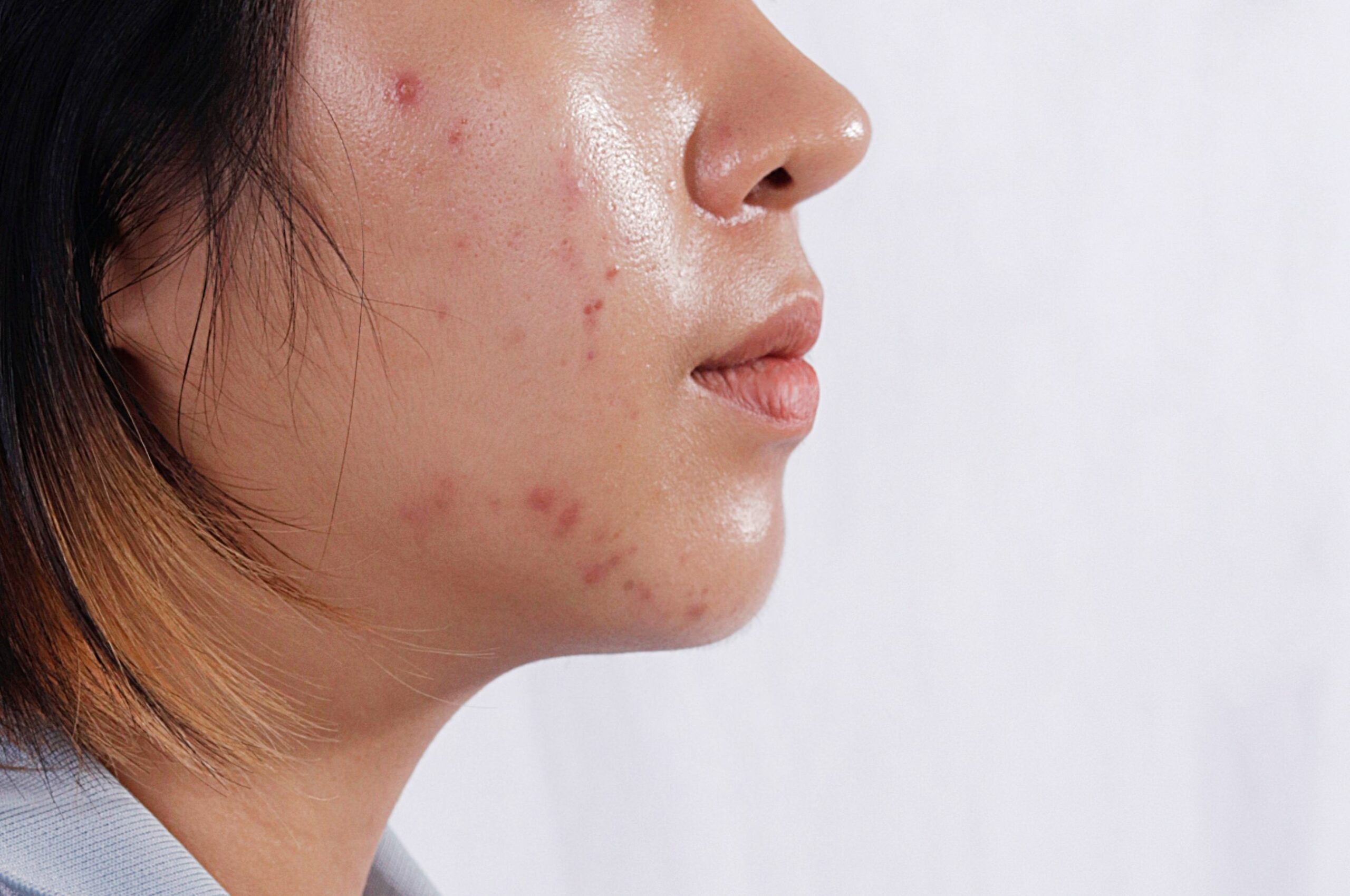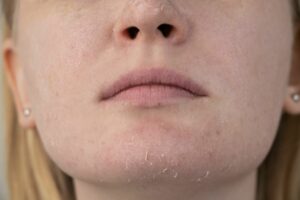1) Keratosis Pilaris
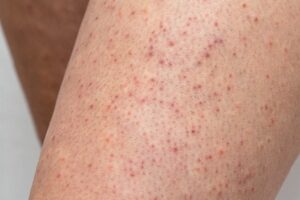
Commonly referred to as “chicken skin,” keratosis pilaris is a skin ailment that results in rough, bumpy patches of skin. The little lumps are caused by dead skin cells clogging hair follicles. Common locations for keratosis pilaris include the thighs, buttocks, cheeks, and upper arms.
Symptoms
- Skin that is itchy and irritating with a minor discolouration around lumps
- Dry, sandpaper-like skin lumps that vary in color according to skin tone (flesh-colored, white, red, pink, brown, or black)
Causes
An accumulation of the hair protein keratin in the pores causes this skin disease. Because of the keratin in your body hair, your follicles that produce new hair are unable to open if you have keratosis pilaris. Consequently, the area where a hair should be appears as a tiny lump.
Diagnosis and Treatment
Medical history and physical examination results are used to diagnose keratosis pilaris. By examining the affected area, a dermatologist, who specializes in skin care, can usually confirm the diagnosis. Among the elements that influence the diagnosis are: how old you are, how your skin appears, and which regions are impacted
To help with dry, itchy skin and to make your skin seem better, your dermatologist might suggest a moisturizing treatment. Dead skin cells can be removed and hair follicle blockages can be avoided with a lot of over-the-counter and prescription topical lotions. What is best for you may be determined by a physician or other healthcare expert. Urea and lactic acid are two items that are frequently found in moisturizing treatments.
2) Stretch Marks

Skin expands or shrinks quickly, leaving scars that resemble bands of lines across your skin. These are called stretch marks. Pregnancy and other quick weight fluctuations are common times for them to appear. For instance, teenagers who are growing up quickly may get some stretch marks.
Symptoms
- Thinner, glossy lines in your skin that may appear whitish over time
- Skin irritation and itching before stretch marks appear
- Indented lines or streaks on your skin, which can vary in length and width pink, purple, Red, bluish, or dark brown streaks — these color marks can vary, depending on your skin color
Causes
Two key factors can cause stretch marks:
- When you stretch your skin
- An increase in cortisone levels in your body. Your adrenal glands secrete the hormone cortisone on their own. On the other hand, excessive levels of this hormone may cause the skin to become less elastic.
Additionally, under some conditions, stretch marks become more likely.
- The skin extends in different ways to accommodate the growing fetus during pregnancy, which causes stretch marks on many people.
- Rapid weight gain or loss can occasionally result in stretch marks. Teens who have experienced a rapid growth spurt may also see stretch marks.
- Because they reduce the flexibility of your skin, corticosteroid creams, lotions, and pills can exacerbate stretch marks.
Diagnosis and Treatment
Stretch marks can typically be identified by a dermatologist by examining your skin. In most cases, they will also go over your medical history because several illnesses could lead to stretch marks. Your doctor may suggest blood, urine, or imaging tests to assist in identifying the underlying cause of your stretch marks if they think it could be a health issue. Time usually causes stretch marks to disappear.
There are treatments available to help enhance their appearance if you don’t want to wait. To minimize the appearance of stretch marks, a dermatologist can provide additional professional advice on the following options:
- Tretinoin cream
- Hyaluronic acid cream
- Pulsed dye laser therapy
- Fractional photothermolysis
- Microdermabrasion
- Excimer laser therapy
3) Hives
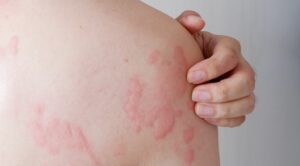
A typical allergic reaction is what causes hives regarding what you have come across or consumed. Your body releases histamines into the bloodstream when you experience an allergic reaction. In an effort to protect itself from illness and other external invaders, your body creates molecules called histamines.
Types of Hives
There are two major types of hives:
- Acute Hives: Acute hives are the most unusual form of hive and generally depart on their own within 24 hours. They are regularly caused by hypersensitivity to food, remedies, insect bites, or other triggers.
- Chronic Hives: They can last for more than six weeks and may be the result of a range of things, including autoimmune issues, together with thyroid disease or lupus infections, along with hepatitis C or HIV medications, including antibiotics and pain relievers, physical triggers, including warmth, bloodlessness, pressure, or exercising.
Here are a few different varieties of hives:
- Cholinergic hives: These hives are due to a rise in body temperature, including from exercising, sweating, or hot showers.
- Cold hives: These hives are a result of exposure to cold temperatures.
- Contact hives: These hives are caused by direct contact with an allergen, such as latex, nickel, or certain flora.
- Dermatographism: These hives are caused by stress on the skin, including scratching or rubbing.
- Solar hives: These hives are a result of exposure to daylight.
- Vibratory hives: Exposure to vibration causes this type of hive.
Symptoms
- Itchy rash. The rash may be crimson, purple, or white, and it can appear anywhere on the frame.
- Hives may be small or massive, and they could come and go quickly.
- Swelling of the face, lips, tongue, or throat.
- Difficulty breathing
- Abdominal ache
- Dizziness
Diagnosis and Treatment
The great remedy for hives relies on its underlying purpose. For acute hives, over-the-counter antihistamines, along with diphenhydramine (Benadryl) or loratadine (Claritin), can commonly help relieve the itching and swelling. In a few cases, prescription antihistamines or corticosteroids can be needed. For persistent hives, remedies may also include a combination of medicinal drugs, which include antihistamines, corticosteroids, and immunosuppressants. In some cases, lifestyle changes, along with avoiding triggers and taking cool baths, can also help. If you have hives, it’s vital to see a dermatologist to determine the underlying motive and get the right remedy.
4) Vitiligo

Vitiligo is a long-term skin condition that causes patches of skin to lose their color. The patches can be any length or shape, and they could appear anywhere on the body. Vitiligo isn’t always contagious, and it is not life-threatening. However, it may cause emotional distress, in particular for humans who have darker pores and skin tones.
Symptoms
- White or light patches of pores and skin. These patches can appear anywhere on the body; however, they are most common on the face, arms, and feet. The patches may also appear on the interior of the mouth, lips, and genitals.
- Premature graying of hair
- Loss of shade in the eyelashes or eyebrows
- Lightening of the internal shade of the mouth or lips
Diagnosis and Treatment
If you notice any such symptoms then immediately go to a doctor. There are treatments that can help slow the progression of the sickness and improve the appearance of the pores and skin. Some of the most common treatments for vitiligo encompass:
Topical corticosteroids: These creams or ointments can help lessen infection and improve the appearance of the pores and skin.
Calcineurin inhibitors: These creams or ointments can also help reduce inflammation and enhance the appearance of the pores and skin.
Light therapy: This remedy entails exposing the affected skin to ultraviolet (UV) light. UV light can help stimulate the manufacturing of melanin.
A dermatologist will see your condition and accordingly recommend treatments. If you want to know about Vitiligo in detail, then check this out.
5) Cellulitis
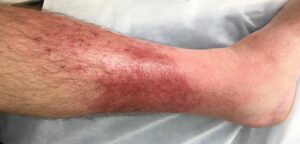
Cellulitis is a common bacterial pore and skin infection that causes redness, swelling, and an ache in the affected location of the skin. The infection can spread fast, so it’s critical to seek a doctor’s help right away if you assume you may have cellulitis.
Symptoms
- Redness and swelling of the skin
- Warmth to touch
- Pain and tenderness
- Fever and Chills
- Blisters
- Pus
Diagnosis and Treatment
Cellulitis is normally dealt with with antibiotics. In some cases, hospitalization may be necessary if the contamination is intense or if the man or woman has a weakened immune system. Do you want to know how cellulitis can affect children? Then check this out.
6) Boils and Abscesses
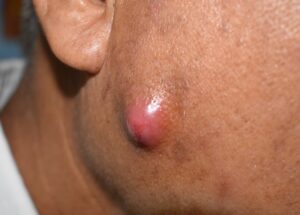
Boils and abscesses are both types of pus under the skin. However, there are some key differences among the two conditions.
Boils are smaller and more superficial than abscesses. They usually shape a hair follicle and are caused by the bacteria Staphylococcus aureus. Boils can appear anywhere on the body; however, they are most common on the face, neck, armpits, and buttocks.
Abscesses may be larger and deeper than boils. They can be shaped anywhere on the body, inclusive of the body. Abscesses may be the result of a number of microorganisms, including Staphylococcus aureus, Streptococcus pyogenes, and Escherichia coli.
Symptoms
- Redness and swelling
- Warmth to the touch
- Pain and tenderness
- Fever
- Pus
Diagnosis and Treatment
Small boils and abscesses can be dealt with at home with warm compresses and over-the-counter pain relievers. Larger boils and abscesses might need to be diagnosed by a dermatologist. In a few cases, antibiotics will also be prescribed.
7) Nail Problems
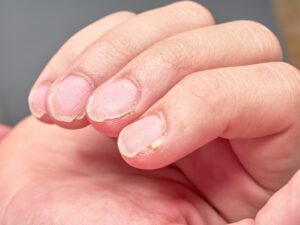
Nail problems are common and may be due to many things such as injury, infection, skin conditions, such as psoriasis and eczema, certain medicinal drugs, medical situations, like diabetes and thyroid disorders, poor diet, poor nail care etc.
Types
Brittle nails: Brittle nails are thin and crack effortlessly. They may be the result of a variety of factors, including a dry climate, overexposure to water, and the use of harsh chemical compounds on your nails.
Splitting nails: Splitting nails are just like brittle nails; however, they tend to split vertically as opposed to horizontally. They can be a result of the same factors that cause brittle nails, in addition to biting your nails or using nail polish remover too regularly.
Ingrown toenails: Ingrown toenails occur while the corner of the toenail grows into the surrounding pores and skin. They can result from wearing footwear that is too tight, slicing your toenails too short, or injuring your toe.
Fungal nail contamination: Fungal nail infections result from a fungus that invades the nail. They can cause the nail to become discolored, thickened, and brittle. Fungal nail infections are more common in toenails than fingernails.
Nail Care
- Keep your nails smooth and dry
- Trim your nails frequently and cut them straight throughout
- Avoid biting your nail
- Wear gloves when working with water or harsh chemicals
- Wear shoes that match properly
- Treat any fungal nail infections promptly
If you’ve got any underlying medical conditions that could contribute to nail problems, make sure to consult a dermatologist.
8) Melasma
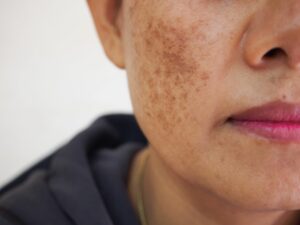
One common skin issue is melasma. It causes skin discolouration, accompanied by black blotches. In cases when it affects pregnant women, it is also known as chloasma, or the “mask of pregnancy.”
Symptoms
Brownish colored patches usually appear on the cheeks, forehead, bridge of the nose and chin.
Diagnosis and Treatment
There are treatments that could help to lighten the dark patches and enhance the appearance of the skin.
Topical medicines: These medicinal drugs are applied at once to the skin and may help to lighten the dark patches. Common topical medicines used to treat melasma consist of hydroquinone, azelaic acid, and kojic acid.
Light-primarily-based remedies: These remedies use one-of-a-kind varieties of mild to interrupt the melanin (pigment) in the pores and skin. Common light-primarily based healing procedures used to treat melasma include intense pulsed mild (IPL) and laser therapy.
Chemical peels: Chemical peels use acids to take away the top layer of skin, which could help reduce the appearance of melasma.
It is crucial to note that each melasma remedy can have side effects, including infection, redness, and dryness. It is critical to speak to your dermatologist about the best treatment alternatives for you.
 Gynecologist
Gynecologist General Physician
General Physician Orthopedician
Orthopedician Dietitian
Dietitian Pediatrician
Pediatrician Dermatologist
Dermatologist Psychiatrist
Psychiatrist Andrologist
Andrologist Diabetologist
Diabetologist Urologist
Urologist Gastroenterologist
Gastroenterologist General Surgeon
General Surgeon Endocrinologist
Endocrinologist Dentist
Dentist Cardiologist
Cardiologist Pulmonologist
Pulmonologist Fertility Specialist
Fertility Specialist Oncologist
Oncologist Neurosurgeon
Neurosurgeon Nephrologist
Nephrologist Neurologist
Neurologist Sports Medicine
Sports Medicine Cosmetologist
Cosmetologist


